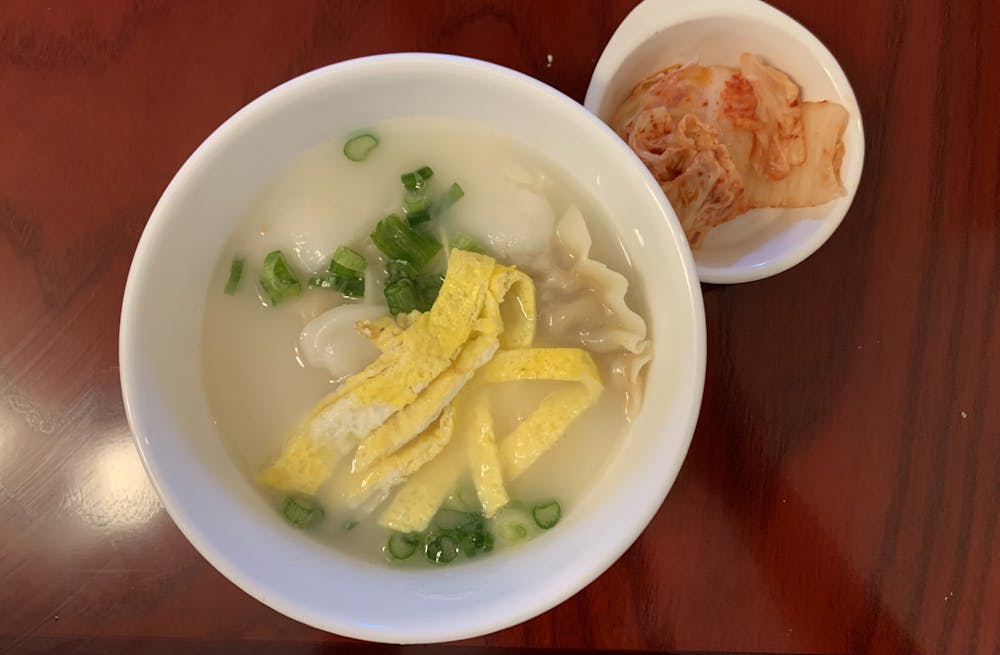Now that the semester is underway and some of us have returned to Charlottesville, the first few waves of homesickness are starting to hit. Whether it’s missing our favorite comfort foods or celebrating the Lunar New Year with family, we’ve decided to share a few recipes to cure both problems. Even if you’re not Korean, these soups are bound to appeal to taste palates of all backgrounds.
First up, Elise shares a recipe for kimchi-jjigae (김치찌개). Kimchi, a spicy fermented cabbage essential to many Korean households, is the star of this flavorful soup. In honor of the upcoming Lunar New Year this Friday, Grace will also share her recipe for tteokguk (떡국). Usually filled with dumplings and sliced rice cakes, this soup symbolizes good luck and longevity and is traditionally eaten on both New Year’s and Lunar New Year’s. The latter holiday, also known as Seollal (설랄), marks the first day of the Korean Lunar Calendar and is arguably one of the most important Korean holidays. In East Asia, age is incremented at the start of the calendar year instead of the individual’s birthday, so consuming a bowl of tteokguk is traditionally the key to aging one year older! However, both of these well-loved soups are enjoyed year-round and make for a hearty meal.

Each family has their own unique way of making this traditional Korean cuisine, but most renditions will at least include kimchi and tofu.
Kimchi-jjigae — Elise Kim
Kimchi-jjigae is a one-pot wonder that never fails to flood me with nostalgia. Each family has their own unique way of making this traditional Korean cuisine, but most renditions will at least include kimchi and tofu. My mom’s recipe is objectively more similar to budae-jjigae (부대찌개) — a Korean army base stew typically topped with sliced rice cakes, sausages and ramen noodles — but it is still a recipe that will always remind me of home.
Prep Time: 5 minutes
Cook Time: 30 minutes
Yields: 5 servings
Ingredients:
2 tablespoons sesame oil
½ cup raw pork belly, sliced
2 cups kimchi, chopped
½ cup kimchi brine
One 16 oz. pack of firm tofu, sliced
One 6 oz. can of tuna
½ can of Spam meat, sliced
Green onion for optional garnish
Instructions:
- In a small pot on medium-high heat, add two tablespoons of sesame oil. Once the bottom of the pot starts steaming, add the sliced pork belly and stir for about five minutes or until lightly browned.
- Add the kimchi and kimchi brine to the pot. If your kimchi is not already cut into one-inch pieces, make sure to chop it on a cutting board before adding it in.
- Cut the Spam meat into quarter-inch slices and add on top, followed by the tuna and enough water to submerge almost all of your ingredients. For more flavor, add the oil from the canned tuna instead of draining it.
- Gently mix so that everything has been soaked in the broth. Cover the pot with a lid, bring to a simmer and cook for about 10 minutes.
- Slice all of your tofu into quarter-inch slices and arrange it on top of the stew.
- Cover the stew again and let simmer for about 20 minutes on medium-low heat.
- Your kimchi-jjigae is ready to eat! As an optional but highly recommended step, serve alongside a bowl of hot rice and garnish with some chopped green onion for a bit of flair.
You can also make a vegetarian kimchi-jjigae by stir-frying your kimchi instead of pork belly and foregoing the tuna and Spam meat in the third step. Steeping an anchovy broth packet in a pot of hot water for 10 minutes is another way to create your broth. If you prefer a more umami taste than stir-fried kimchi, you can purchase these flavor-packed anchovy packets at any Korean grocery store.

Tteokguk — Grace Park
Similar to kimchi-jjigae, every family has their own unique way of making tteokguk, but it is very simple to make, especially if you are able to buy premade broth. Below is the recipe that I use when I am on Grounds and crave a home-cooked meal away from home.
Prep Time: 5 minutes
Cook Time: 30 minutes
Yields: 5 servings
Ingredients:
1 pound rice cake slices
1 stalk green onion, chopped
1 teaspoon minced garlic
One 32 fl oz. chicken stock carton
3 dumplings, optional
2 eggs, optional
Salt and pepper to taste
Toasted seaweed for garnish
Instructions:
- Pour your chicken stock into a small pot on medium-high heat. While the soup is heating up, soak the rice cakes in room-temperature water in a separate bowl for about seven minutes — this will help them loosen up so they can cook faster.
- Once the broth comes to a boil, add your minced garlic, rice cakes and dumplings.
- While your tteokguk is cooking, you can work on preparing your garnishes. In a small bowl, whisk your eggs until thoroughly combined. Oil a medium-sized pan on low heat, add the egg mixture and spread it evenly around the pan as if you were cooking an omelette.
- Let cook for 30 seconds, then flip it to let the other side cook until your egg is no longer raw. Remove from heat and transfer to a cutting board. Fold the egg into thirds, then slice into thin strips and set aside.
- After your rice cakes are cooked — about eight minutes or until slightly softened — and your dumplings are hot all the way through, turn the heat down to low and boil for five more minutes.
- If needed, add salt and pepper to taste before removing from heat. Transfer your soup to a separate bowl and garnish with toasted seaweed strips, egg slices and green onions.
You can definitely make your own stock, but if you don’t have time, using premade stock is a perfect way to create an easy delicious meal. If making your own broth, you can also make this a vegetarian tteokguk since the homemade stock soup is flavored with anchovies rather than beef.
Ironically, Grace would choose a steaming bowl of kimchi-jjigae over tteokguk, but Elise’s embarrassingly low spice tolerance only further affirms her preference for tteokguk out of the two soups. However, there’s no doubt that enjoying either one of these — or both in tandem — on a cold winter evening is a delicious cultural experience that everyone should try.






